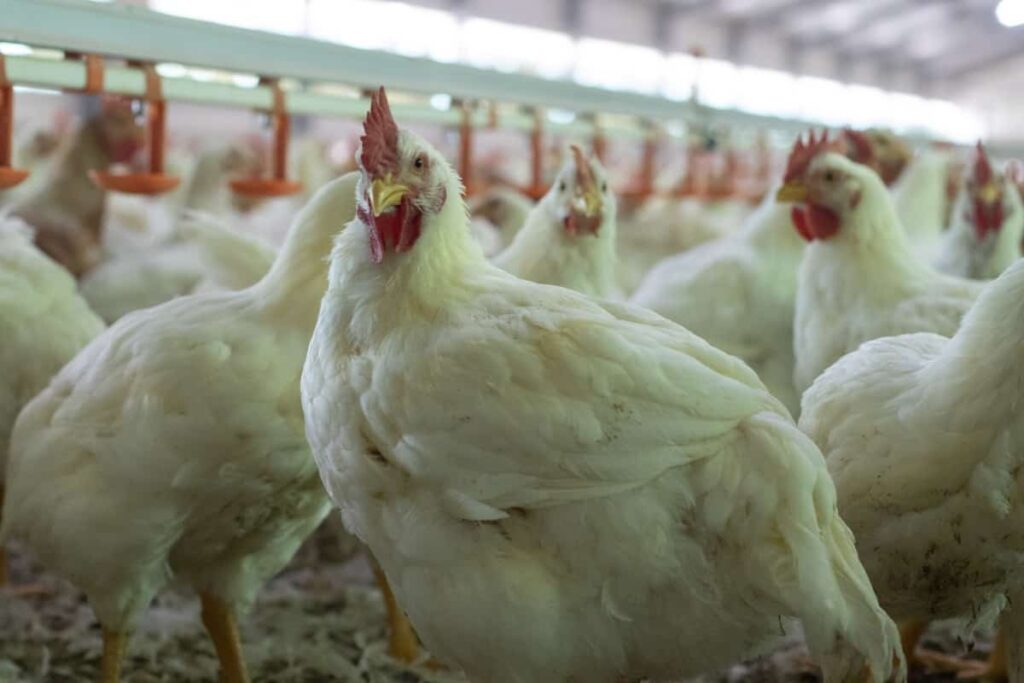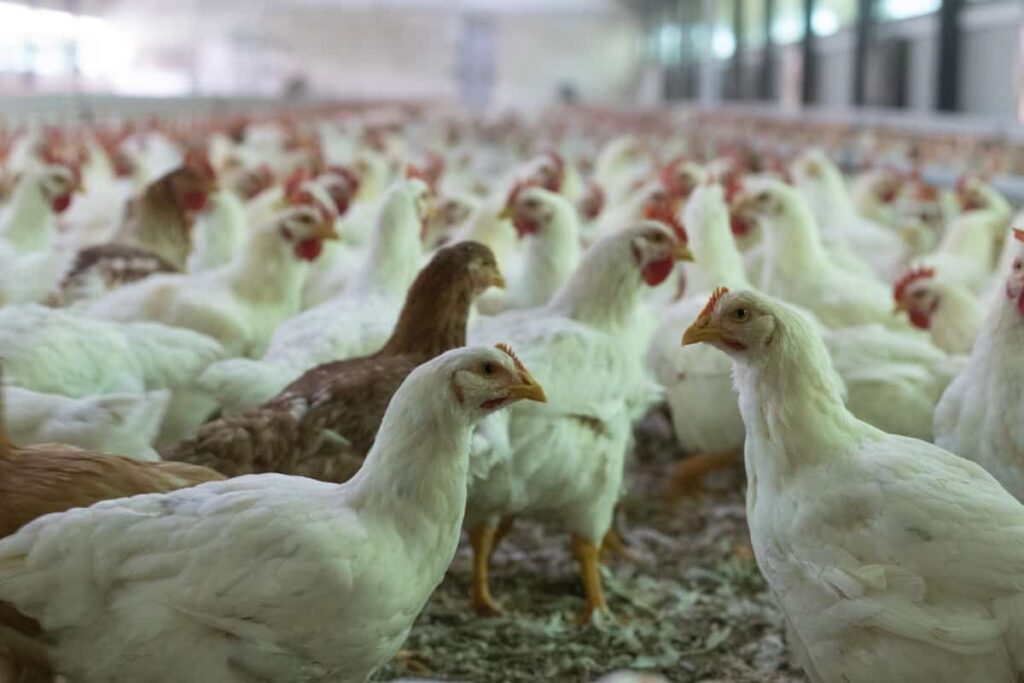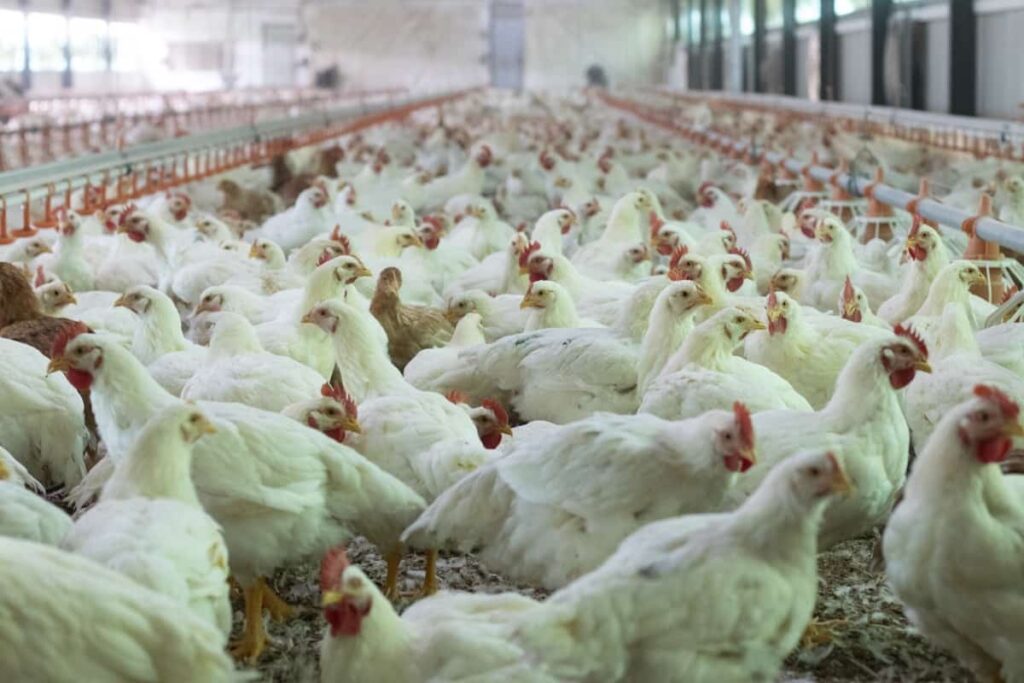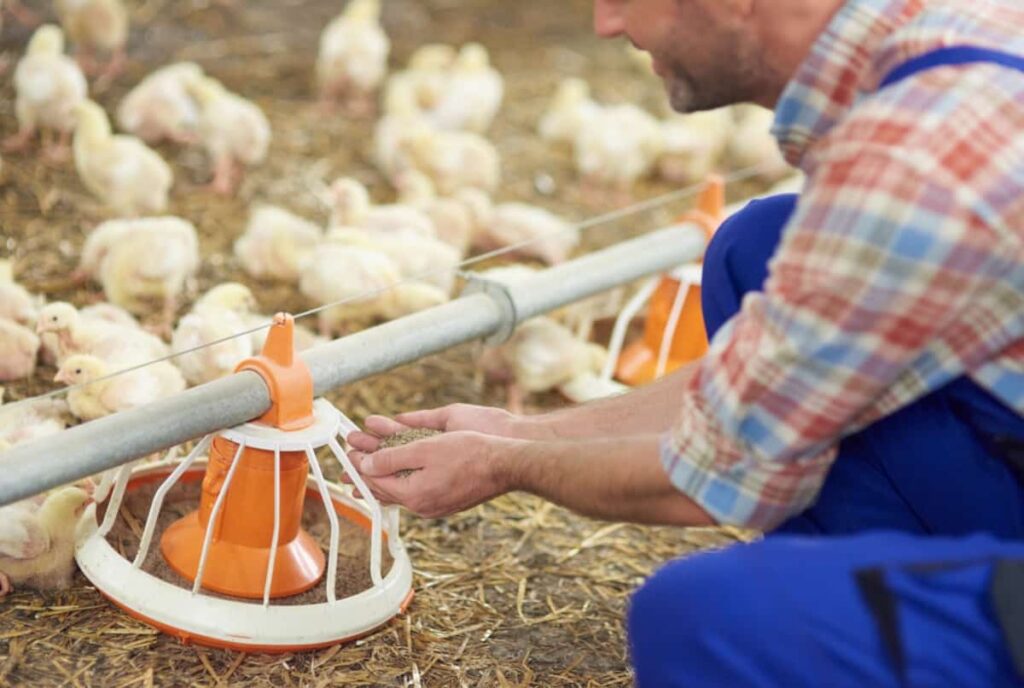Welcome to our blog on broiler chicken farming! If you’ve ever considered starting your broiler chicken farm, it’s essential to understand the economics behind it. Conducting a cost and profit analysis is crucial for ensuring the success and profitability of your venture.

This blog will dive into broiler chicken farming, examining costs, revenue generation opportunities, and the project’s overall profitability. Whether you’re a prospective farmer or simply curious about the economics of broiler chicken farming, this blog will provide valuable insights and a comprehensive project report.
Introduction to Broiler Farming
Poultry meat is a valuable source of high-quality proteins, minerals, and vitamins, crucial in balancing the human diet. Broiler farming offers specially bred chicken varieties with rapid growth and high feed conversion efficiency. This type of farming can serve as the primary income source for families or provide additional Revenue and steady employment opportunities for farmers throughout the year.
The nutrient-rich poultry manure can effectively be used as fertilizer to enhance crop yields. The advantages of broiler farming include lower initial investment compared to layer farming, a short rearing period of only 5-6 weeks, the ability to house more flocks in the same shed, high feed conversion efficiency, faster returns on investment, and a higher demand for poultry meat compared to sheep or goat meat. These benefits make broiler farming an attractive and lucrative option for farmers seeking sustainable income and market demand.
Definition and Characteristics of Broiler Chickens
Broiler chickens, scientifically known as Gallus gallus domesticus, are specifically bred and raised for meat production. They are commonly referred to as broilers. Commercial broilers typically reach their slaughter weight within four to six weeks, although slower-growing breeds may take around 14 weeks.
Their white feathers and yellowish skin recognizes these chickens. It’s worth noting that the term “broiler” or “broiler-fryer” is sometimes used to distinguish younger chickens weighing under 2.0 kilograms (4+1/2 lb) from larger roasters. However, broiler chickens are prone to various welfare concerns due to the breeding selection for rapid growth and the specific husbandry practices employed.
In case you missed it: Understanding Backyard Poultry/Chicken Farming at Home: Check How this Guide Helps Beginners

These include skeletal malformation and dysfunction, skin and eye lesions, and congestive heart conditions. It is essential to regularly assess and manage factors like ventilation, housing, stocking density, and in-house procedures to ensure the flock’s well-being. Broiler chickens are typically raised in large sheds under intensive conditions with mixed-sex flocks. The breeding stock, known as broiler-breeders, also has welfare concerns related to high feeding motivation and beak trimming.
Scope for Broiler Farming and its Importance
Broiler farming has experienced significant growth, making it the fifth-largest global broiler meat producer with an annual production of 2.47 million MT. However, the per capita availability of poultry meat remains low at 2.96 kg, far below the recommended 11 kg by the ICMR.
The sector’s success can be attributed to corporate sector support and favorable government policies. Broiler farming provides employment opportunities to over 5 million people in rural areas through backyard production and small-scale commercial units. Improved management practices, access to quality resources, reduced disease outbreaks, and lower mortality rates contribute to its growth.
Best Broiler Chicken Breeds for High Profits and Commercial Farming
- Cornish Cross: This breed is widely recognized for its rapid growth and efficient feed conversion, making it a popular choice in commercial broiler farming.
- Cobb 500: Known for its excellent feed conversion ratio and meat yield, the Cobb 500 is a widely used breed worldwide.
- Ross 308: Renowned for its fast growth, feed efficiency, and strong disease resistance, the Ross 308 is a preferred choice for commercial broiler production.
- Hubbard: Hubbard breeds, such as Hubbard F15, are known for their high growth rate, feed efficiency, and adaptability to different climates.
- Arbor Acres: Arbor Acres broilers are highly valued for their rapid growth, efficient feed conversion, and good meat quality.
- Indian River: This breed is known for its adaptability to various environmental conditions, fast growth, and good meat yield, making it suitable for commercial farming in India.
- Lohmann Broiler: Lohmann Broilers are favored for their excellent growth rate, high feed efficiency, and good meat quality.
- Sasso: Sasso breeds, such as Sasso X44, are known for their slower growth, excellent meat quality, and suitability for free-range or organic production systems.
- Hubbard ISA: The Hubbard ISA breed combines fast growth, efficient feed conversion, and excellent meat quality, making it a preferred choice for commercial broiler farming.
- Vencobb: Widely used in India, Vencobb broilers are known for their fast growth, adaptability to different environments, and high meat yield.
Factors Influencing Broiler Chicken Production
House temperature: Maintaining a consistent and optimal temperature in the poultry house is crucial for maximizing feed conversion. Broilers perform best when there is minimal temperature variation throughout the day. Cold temperatures increase feed consumption for maintaining body temperature, resulting in lower meat production. On the other hand, high temperatures reduce feed intake and efficiency, as energy is diverted toward cooling mechanisms.
Litter quality: The condition of the litter, which comprises bedding material, excreta, feathers, wasted feed, and water, significantly influences broiler performance. Poor litter quality can lead to health issues and reduced feed conversion. Proper litter management is essential to maintain a clean and dry bird environment.
Feed wastage and deprivation: Excessive feed wastage and deprivation negatively impact feed conversion. Proper feeder management, such as frequently adding small quantities of feed and avoiding early and high feeder raising, helps prevent feed wastage and ensures regular feeding.
In case you missed it: Best Package Practices to Grow Chickpeas: Cultivation and Production of Bengal Gram/Chana

Diseases and culling: Disease outbreaks and inadequate culling of unhealthy birds can affect feed conversion. Sick broilers have reduced feed intake and poor performance. Early detection, prompt treatment, and appropriate vaccination strategies are crucial for maintaining flock health and optimizing feed conversion.
Human factors: Research suggests human behavior and broiler fear levels can influence productivity. Reduced fear levels in broilers can enhance their productivity. Minimizing stressors such as sudden movements from stock persons during the early stages of broiler growth is important. As broilers become habituated to human presence, their susceptibility to stressors decreases.
Importance of Conducting Cost and Profit Analysis
Cost and profit analysis is essential in broiler farming to ensure financial viability and make informed decisions. It allows farmers to accurately assess the expenses involved in production, including feed, labor, housing, and veterinary costs. By analyzing the costs incurred against the Revenue generated from broiler sales, farmers can determine the profitability of their operations.
This analysis helps identify areas where costs can be reduced, and efficiencies can be improved, ultimately maximizing profits. Additionally, it aids in evaluating the feasibility of expanding the business or implementing new strategies. Regular cost and profit analysis provides valuable insights for effective financial management and long-term sustainability in broiler farming.
Cost Analysis of Broiler Chicken Farming
By analyzing these costs, farmers can identify areas where they can optimize spending, reduce wastage, and improve profitability. It also helps set realistic pricing strategies and make informed decisions regarding resource allocation.
Capital Investment and Infrastructure Costs
- Land and farm setup: The cost of purchasing or leasing land for the broiler farm and preparing it for farming activities, including fencing, leveling, and infrastructure development.
- Housing and equipment: The expenses associated with constructing or purchasing broiler houses, ventilation systems, heating equipment, feeding and watering systems, and other necessary infrastructure.
Operational Costs
- Procurement of chicks: The cost of purchasing day-old broiler chicks from hatcheries.
- Feed and nutrition expenses: The expenses related to procuring high-quality feed and supplements for broilers contribute to their growth and overall health.
- Labor costs: The wages and salaries paid to farm workers involved in various tasks such as feeding, cleaning, and managing the broiler houses.
- Veterinary services and healthcare expenses: The expenses associated with veterinary consultations, vaccinations, medications, and general healthcare services ensure the well-being of the broilers.
Utilities and Miscellaneous Expenses
- Electricity, water, and waste management: The costs incurred for the farm’s electricity consumption, water supply, and waste management systems.
- Insurance and administrative costs: The expenses related to insurance coverage for the farm, administrative tasks such as record-keeping, licenses, permits, and other miscellaneous expenses.
In case you missed it: Sustainable Poultry Farming: Benefits and How to Reduce Your Carbon Footprint with Chickens

Revenue Generation in Broiler Chicken Farming
Revenue generation in broiler chicken farming relies on understanding the market, identifying consumer preferences, implementing appropriate pricing strategies, and leveraging various sales channels. Market analysis helps farmers identify target markets and tailor their production accordingly.
Direct sales to consumers can yield higher profits, while wholesale and distribution networks enable wider reach. Estimating sales volume and Revenue requires setting achievable targets based on market conditions and implementing cost-effective marketing techniques to attract customers.
Market Analysis and Demand Assessment
- Local and regional market evaluation: Assessing the local and regional market dynamics, including consumer preferences, purchasing power, and competition, to understand the demand for broiler chicken.
- Understanding consumer preferences and trends: Analyzing consumer preferences, such as preferences for specific cuts or organic products, and staying updated on market trends to align production and offerings accordingly.
Pricing Strategy and Sales Channels
- Direct sales to consumers: Selling broiler chicken directly through farm stands, farmer’s markets, or online platforms, allowing for higher profit margins.
- Wholesale and distribution networks: Establishing partnerships with wholesalers, retailers, and restaurants to distribute broiler chicken in larger volumes, reaching a wider customer base.
Estimating Sales Volume and Revenue
- Projected growth and sales targets: Setting realistic sales targets based on market research, production capacity, and growth projections to achieve revenue goals.
- Cost-effective marketing and promotion techniques: Implementing marketing strategies such as social media advertising, local promotions, and collaborations to increase brand visibility, attract customers, and drive sales.
Project Report of Broiler Chicken Farming: Profit Analysis and Return on Investment (ROI)
Profit analysis involves evaluating a business or project’s financial gains and profitability. It assesses the Revenue generated, deducts the costs and expenses incurred, and calculates the net profit. Return on Investment (ROI) measures the profitability of an investment by comparing the net profit to the initial investment.
It is calculated by division of net profit by the initial investment and expressing it as a percentage. Profit analysis and ROI are essential in assessing the viability and success of a venture, helping investors and business owners make informed decisions, and determining the efficiency and effectiveness of capital allocation.
The cost analysis of a broiler poultry farm project (500 birds per week)
| Economic Parameters | Amount |
| Cost of Construction of Shed (Rs 10/sq.ft) | Rs 400,000 |
| Cost of Store Room (200 sq ft @ Rs 125/sq ft) | Rs 25,000 |
| Cost of Labour Quarters (150 sq ft @ Rs 150/sq ft) | Rs 22,500 |
| Expenditure on Water Supply (Overhead tank, bore, motor) | Rs 50,000 |
| Installation of Electricity | Rs 25,000 |
| Cost of Equipment (Feeders, waterers, brooders, etc.) | Rs 48,000 |
In case you missed it: Country/Free Range Chicken Farming Project Report: Business Plan, Investment, Profit, and Loan in India

| Total Non-Recurring Expenditure | Rs 570,500 |
| Cost of Chicks (4,000 chicks @ Rs 20/chick) | Rs 80,000 |
| Insurance (4% of total cost) | Rs 3,200 |
| Cost of Feed (4 kgs/bird, Rs 16/kg for 4,080 birds) | Rs 261,120 |
| Cost of Medicines, Vaccines, etc. | Rs 20,000 |
| Labour Cost (for 3 months @ Rs 4,000/month) | Rs 12,000 |
| Total Recurring Expenditure (1st 8 batches) | Rs 376,320 |
| Total Cost of the Project | Rs 946,820 |
The cost analysis includes both non-recurring expenditures for the setup of infrastructure and recurring expenditures for the initial batches. The non-recurring expenditure covers the cost of sheds, storerooms, labor quarters, water supply, electricity installation, and equipment. The recurring expenditure includes the cost of chicks, insurance, feed, medicines, and labor for the first 8 batches. The total cost of the project sums up to Rs 946,820.
Economics of Broiler Farming: Cash Flow Analysis
In the project report for a broiler poultry farm with a capacity of 500 birds per week, the cash flow analysis reveals the costs and benefits over three phases: Phase I, Phase II-V, and Phase VI.
Phase I – Initial Investment
- Capital cost: Rs 570,500
- Recurring costs include the cost of chicks, feed, insurance, medicines, and labor.
- Total costs for Phase I: Rs 1,869,600
Phase II-V – Regular Operations
- Recurring costs continue with an increased number of batches and birds.
- Total costs for Phase II-V: Rs 2,416,080
Phase VI – Closing Years
- Recurring costs remain the same as in Phase II-V.
- The depreciated value of sheds and equipment is considered.
- Total costs for Phase VI: Rs 2,416,080
Benefits
- Revenue from the sale of birds and other sources.
- The depreciated value of sheds and equipment.
- Total benefits for Phase I: Rs 2,114,500
- Total benefits for Phase II-V: Rs 2,743,000
- Total benefits for Phase VI: Rs 3,162,500
In case you missed it: Free-Range Chicken Farm Operations Management: Month-Wise Maintenance For Better Profits

Net Benefits
- Net benefits for Phase I: Rs 244,900
- Net benefits for Phase II-V: Rs 326,920
- Net benefits for Phase VI: Rs 746,420
The cash flow analysis shows that the broiler poultry farm project generates positive net benefits throughout its duration. The initial investment is recouped in Phase I, and subsequent phases yield increasing returns.
Conclusion
The cost and profit analysis of broiler chicken farming provides valuable insights into the financial aspects of the project. Stakeholders can make informed decisions and assess the venture’s viability by carefully evaluating the costs and potential profits.
- How to Raise Pigs in Your Own Backyard: A Comprehensive Guide
- Budget Friendly Sheep Shed Ideas: Cheap and Low-Cost Tips
- How Much Do Cattle Farmers Make: Revenue Streams in Cattle Farming
- Management Pests and Diseases in Your Cotton Field
- Sheep Farming Business Plan for Beginners
- Aquaponic Farming at Home: A Step-By-Step Guide
- Profitable Village Farming Business Ideas in 2024
- High-Yield Aquaculture: Fast-Growing Fish for Farming
- Effective Fish Pond Construction Techniques for Beginners
- Irrigation and Water Management in Pineapple Farming
- Blossom to Harvest: Mastering Flowering and Pollination in Papaya Farming
- Pig Fattening Essentials: From Selection to Sale for Beginners
- Raising Wagyu Cattle: A Complete Guide for Premium Beef Production
- Soil Types and Their Water Holding Capacity
- Optimizing Irrigation Schedules for Coconut Groves for Enhanced Yield
- Espresso Your Garden: Coffee Grounds for Healthier Acid-Loving Plants
- The Best Soil Mix for Snake Plants: How to Mix Your Own Snake Plant Soil
- Green Thumb Success: Expert Tips for Cultivating Greenhouse Beans All Year Round
- Bloom All Year Round: The Ultimate Guide to Indoor Hyacinth Care
- Eco-Friendly Gardening: How to Make Liquid Fertilizer from Kitchen Waste
- Ultimate Guide to Grow Anise in Pots: Explore Seed Propagation to Harvesting
- Guide to Raising Chester White Pigs: Discover Breed Facts to Growth Management
- Mastering the Elegance: The Ultimate Guide to Weeping Cherry Tree Care, Planting, and Maintenance
- Ultimate Guide to Planting Garlic in Grow Bags: Growing Strategies for Beginners
- How to Fix Spider Plant Leaf-Related Problems: Natural and Organic Remedies
- 10 Reasons Why Your Tulsi Plant is Shedding Leaves: Home Remedies and Solutions
- Optimizing Growth and Yield: The Advantages of Palm Bunch Ash Fertilizer
- Utilizing Neem Oil Extract as a Natural Pesticide for Hydrangea
- From Soil to Harvest: Various Ways in Which Farmers Can Use AI Tools
- Steps to Encourage and Induce Citrus Flowers: A Comprehensive Guide
- How to Fix Snake Plant Leaf-Related Issues: Natural and Organic Remedies
- Transform Your Garden into a Fragrant Oasis with Raat Ki Rani (Night Blooming Jasmine)
- Discover the Ideal Chicken Breeds for Philippine Farms
- How to Create a Poultry Egg Farm Business Plan for Profits
- Grow Lemon Cucumbers Like a Pro: Insider Techniques for Bountiful Yields
- Ultimate Guide to Caring for Your Pink Princess Philodendron: Tips for Thriving Variegation
